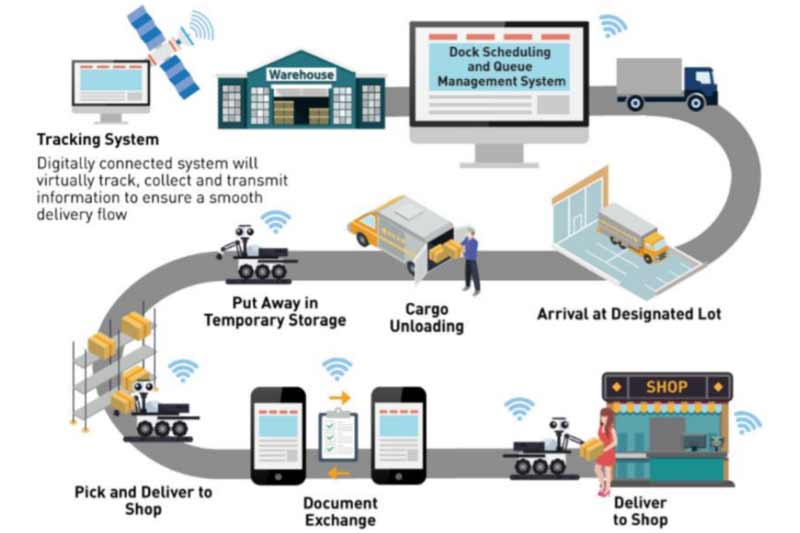
Image credit: IMDA
Today, the Infocomm Media Development Authority of Singapore revealed the Logistics Industry Digital Plan (IDP) for SMEs.
In addition to helping SMEs in the logistics sector to digitalise, the Logistics IDP will also guide SME logistics companies towards participating in impactful national innovation initiatives such as In-Mall Distribution, Federated Lockers, the HIVE (Highly Interconnected and Vibrant E-trade) portal and the National Trade Platform (NTP).
In a factsheet attached to the press release, details are provided on some of these sector-wide projects, which aim to create a digitally-enabled distribution eco-system. Shared infrastructure and consolidated deliveries can help in asset optimisation across the sector, rather than only at enterprise level.
In-mall Distribution (IMD)
The IMD concept is enabled by various technologies including a dock scheduler and queue management system, where logistics service providers are able to book time slots to make deliveries. This solution will significantly reduce vehicle delivery queues into a mall.
The IMD process also involves an In-Mall Logistics Operator (IMO) stationed within the mall unloading bay to receive and consolidate deliveries from suppliers before making the last-mile delivery to retailers within the mall.
In addition, the IMO can offer other value-added services such as unloading bay facility management, security pass management, concierge services (e.g. bag/luggage deposit, cold storage facility), home delivery, meal delivery for F&B establishments, e-commerce pickup service and Just-In-Time replenishment or goods transfer for retailers.
Dock Scheduler and Queue Management (DSQ) System
The DSQ was deployed for the IMD at Tampines Mall in June 2016. This solution can also be used at the Offsite Consolidation Centre (described below).
The DSQ deployed at Tampines Mall provides last mile delivery visibility to the Mall tenants and identifies vehicles that overstay in the mall loading bay lots. It can react to deliveries coming too early and remove original booking slots for others as necessary.
The DSQ system also analyses data, develops reports and sends alerts to process administrators, allowing planners to gain insights and make data-driven decisions on the process to benefit IMOs, drivers and retailers.
Both internal and external users can access the application anytime via multi platforms, so that multiple parties can log on to make bookings and IMO personnel can verify approved vendors for their delivery timeslots.
Offsite Consolidation Centre

The In-Mall Distribution can work with another Urban Logistics model – the Offsite Consolidation Centre (OCC). Before delivering to malls, trucks with less-than-full loads can consolidate and sort their goods in the OCC. Goods can be re-loaded and then delivered to their intended destinations on a single truck within the same day. This reduces the number of trucks going to the same destination and improves truck load utilisation.
Technologies such as cloud-based dock scheduling solutions and queue management systems, can be similarly deployed to enable efficient goods delivery.
Advanced robotics can also be deployed to help sort goods, while fleet optimisation solutions can enable smooth, tracked and optimised delivery from the source to the destination.
Community-Based Track & Trace System
Complementarily IIMDA is also conducting a community-based track and trace system trial for the OCC users and operators to better track their cargoes across the supply chain. This solution will provide actionable visibility to both consignor and consignee across multiple stakeholders managing different parts of the supply chain, giving them better certainty of the fulfilment service and the ability to intervene in a timely manner to manage potential service lapses or contingencies.
Federated Lockers

This is an open delivery network, comprising parcel lockers and collection points, to work alongside existing door-to-door delivery. This will help improve productivity for last mile delivery services. Whenever deliverymen arrive at the recipient’s home when no one is in, cost per delivery goes up.
Federated lockers will provide an alternative delivery option to consumers to collect their purchases at their convenience.
The nation-wide parcel locker network is intended to be pervasive enough for consumers to reach the nearest locker from their home within the walking distance of 250 meters, or along the consumer commute path to work or returning home in part of the public transport network.
There might be many different locker hardware and interfaces in the network. An inter-operable platform will be deployed to allow users such as merchants, market places, logistics service providers and end consumers to have a consistent and uniform interaction with the federated lockers network.
















